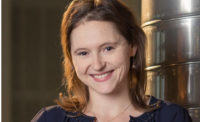Name: Caroline R. Kelty
Age: 35
Title: Mechanical engineer, CMTA Inc.
Educational Experience: B.S. mechanical engineering – University of Kentucky, Lexington, Kentucky, 2007 and B.S. engineering arts – Georgetown College, Georgetown, Kentucky, 2007.
Professional Credentials/Accreditations: P.E. Kentucky, mechanical engineer, and LEED Accredited Professional
Organizational Affiliations/Achievements/Awards: ASHRAE Bluegrass Chapter – vice president, chair, vice chair, membership promotion chair, board of governors; ASHRAE national society – chair of Young Engineers in ASHRAE, Young Engineers in ASHRAE regional representative, membership promotion regional vice chair, committee vice chair, and membership promotion committee; Berea College Deep Green Residence, Berea, Kentucky – LEED Platinum; Living Building Challenge Petal Recognition; Zero Energy Ready; first place technology award, ASHRAE Region VII; first place technology award, ASHRAE national society; Rosa Parks Elementary School, Lexington, Kentucky – 2012 EBie Award, Reformed Gas Guzzler Category from the U.S. Green Building Council (USGBC); 2012 National Green Ribbon School Award from the U.S. Department of Education; and Wellington Elementary School, Lexington, Kentucky – 2014 National Green Ribbon School Award from the U.S. Department of Energy (DOE)
When did you fall in love with engineering?
I fell in love with problem solving at a very early age. One of my favorite childhood activities was putting together puzzles, and I often had to be torn away from the puzzle table until it was completed. I believe this passion was the foundation for enjoying math and physics problems.
What has been the most rewarding aspect of working in the skilled trades?
The most rewarding aspect of the skilled trades is the finished product. Seeing a design come to life from a set of plans and specs and knowing that design is going to withstand decades of serving individuals as an environment that will educate, heal diseases, and build communities is very exciting. It’s rewarding to be involved in the conceptual part of creating that environment.
What challenges do women face in this profession? Why aren’t there more women in engineering?
The main challenge is standing out against your male peers and yet knowing you belong with those peers. I believe there aren’t more women in engineering because it is generally believed that engineering is a field that is devoid of “caring or providing” for the community, and women interested in the sciences often go into medicine as a more “caring” profession. This is a serious misconception of the role of engineers in creating communities. The systems I design provide indoor environments where children can proficiently learn, surgeons can perform miracles, and residents can sleep soundly all while protecting the environment by being energy efficient.
Describe what your job entails on a day-to-day basis.
My job entails collaborating and coordinating with architects and owners to provide a safe, aesthetically beautiful, sustainable, and environmentally friendly facility for the building occupants. To name a few day-to-day tasks, I utilize building modeling to incorporate the necessary mechanical systems within the building design, conduct energy model analysis to ensure efficient system/s selections within the design, and provide cost estimate analysis to ensure the facility can meet the project budget.
What drives/motivates you every day?
We spend 87 percent of our lives indoors, so being able to positively impact that space is truly rewarding and a major motivating aspect of my job. Aside from the designs I create, providing an example of a well-rounded individual to my children is a major motivation. I hope to show them that you can positively impact the world around you by using the abilities you learn and develop.
Describe the proudest moment in your career.
Being a part of the Berea Deep Green Residence Hall project was one of the proudest moments of my career. The project’s mission was to provide the most energy-efficient residence hall in the nation while not sacrificing comfort and indoor environment. The project succeeded through sustainable system selections, building management, and renewable energy sources. Due to these efforts, the building achieved its goal and has won several prestigious awards.
What remains on your engineering bucket list — what do you aspire to do that you haven’t done yet?
I would love for one of my previous designed buildings to meet zero-energy design. Our company strives to create sustainable designs that are zero-energy ready, meaning the energy usage reduced to the point that an additional renewable energy source could be obtained to offset the building’s total annual usage. I would love to see our efforts to reduce annual energy usage be capitalized on by our clients.
What’s one thing no one knows about you?
My husband and I courageously purchased a home that was built in the 1890s. We have been renovating it from the guts to the outside, and it has really been a journey. Everything from the old knob-and-tube wiring to the horse hair found in the plaster walls to the original wood floors has been an adventure and to be able to do the work mostly ourselves has been gratifying. To see the transformation from the 1960s “upgrade” back to the grand historical farmhouse style it used to be has been amazing.
List any mentors who’ve helped you succeed and describe exactly how they’ve shaped your success.
My first mentors would be my family, my mom, and grandparents. They always encouraged my love for problem solving and never gave me any doubts that I couldn’t do something because it was perceived as hard. They will be so proud that I’ve been given this honor. Also, Ms. Leverenz, my math professor at Georgetown College, who urged me to get involved with women in engineering at UK to make sure I saw all the other ladies who were in the field. While I was a co-op student at CMTA, Donny Crayne and Jeremy Smith showed me how rewarding it is to be a consulting engineer. Finally, my coworkers — never have I ever felt more support from a group of individuals. As one of the two female engineers at my office, my design input is sought after equally as that of my peers. CMTA management has set straight contractors when they saw any sort of disrespect, and they’ve never made me feel that I was inept based on my gender.
What does the future hold for you?
I would like to continue to mentor the next generation of engineers to push our building designs to be as efficient and sustainable as possible.
What advice do you have for prospective female engineers considering entering the field?
This field uses more than the academic requirements of an engineering degree. It will expand your knowledge of the operations within several facility types you encounter. I’ve learned what key components are at a presentation board for a teacher to engage his/her classroom; what a welder needs at his/her booth; what it takes for a photographer to develop his/her art work; the critical lighting positioning needed for a surgeon as well as countless pieces of equipment that occupants use in their hospitals, schools, and offices that allow them to do their jobs. However, without my designs, they can’t perform their necessary day-to-day tasks.
If you enjoy learning how things work and collaborating with individuals to build your indoor environment this is the field for you. I would encourage future female engineers to know even if they are the minority in their classes, there have been others before them, and they shouldn’t let the fact that they don’t see a familiar face deter them from doing something that they love.




